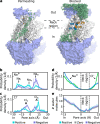Molecular mechanisms of ion conduction and ion selectivity in TMEM16 lipid scramblases
- PMID: 33990555
- PMCID: PMC8121942
- DOI: 10.1038/s41467-021-22724-w
Molecular mechanisms of ion conduction and ion selectivity in TMEM16 lipid scramblases
Abstract
TMEM16 lipid scramblases transport lipids and also operate as ion channels with highly variable ion selectivities and various physiological functions. However, their molecular mechanisms of ion conduction and selectivity remain largely unknown. Using computational electrophysiology simulations at atomistic resolution, we identified the main ion-conductive state of TMEM16 lipid scramblases, in which an ion permeation pathway is lined by lipid headgroups that directly interact with permeating ions in a voltage polarity-dependent manner. We found that lipid headgroups modulate the ion-permeability state and regulate ion selectivity to varying degrees in different scramblase isoforms, depending on the amino-acid composition of the pores. Our work has defined the structural basis of ion conduction and selectivity in TMEM16 lipid scramblases and uncovered the mechanisms responsible for the direct effects of membrane lipids on the conduction properties of ion channels.
Conflict of interest statement
The authors declare no competing interests.
Figures







Similar articles
-
Membrane lipids are both the substrates and a mechanistically responsive environment of TMEM16 scramblase proteins.J Comput Chem. 2020 Mar 5;41(6):538-551. doi: 10.1002/jcc.26105. Epub 2019 Nov 21. J Comput Chem. 2020. PMID: 31750558 Free PMC article.
-
Atomistic insight into lipid translocation by a TMEM16 scramblase.Proc Natl Acad Sci U S A. 2016 Dec 6;113(49):14049-14054. doi: 10.1073/pnas.1607574113. Epub 2016 Nov 21. Proc Natl Acad Sci U S A. 2016. PMID: 27872308 Free PMC article.
-
The Groovy TMEM16 Family: Molecular Mechanisms of Lipid Scrambling and Ion Conduction.J Mol Biol. 2021 Aug 6;433(16):166941. doi: 10.1016/j.jmb.2021.166941. Epub 2021 Mar 16. J Mol Biol. 2021. PMID: 33741412 Review.
-
Structure-Function of TMEM16 Ion Channels and Lipid Scramblases.Adv Exp Med Biol. 2021;1349:87-109. doi: 10.1007/978-981-16-4254-8_6. Adv Exp Med Biol. 2021. PMID: 35138612 Free PMC article.
-
Wide-ranging cellular functions of ion channels and lipid scramblases in the structurally related TMC, TMEM16 and TMEM63 families.Nat Struct Mol Biol. 2025 Feb;32(2):222-236. doi: 10.1038/s41594-024-01444-x. Epub 2024 Dec 23. Nat Struct Mol Biol. 2025. PMID: 39715905 Review.
Cited by
-
In or out of the groove? Mechanisms of lipid scrambling by TMEM16 proteins.Cell Calcium. 2024 Jul;121:102896. doi: 10.1016/j.ceca.2024.102896. Epub 2024 May 9. Cell Calcium. 2024. PMID: 38749289 Free PMC article. Review.
-
Structure and function of the human apoptotic scramblase Xkr4.Nat Commun. 2025 Aug 8;16(1):7317. doi: 10.1038/s41467-025-62739-1. Nat Commun. 2025. PMID: 40781244 Free PMC article.
-
Calcium-activated chloride channel TMEM16A opens via pi-helical transition in transmembrane segment 4.Proc Natl Acad Sci U S A. 2025 May 6;122(18):e2421900122. doi: 10.1073/pnas.2421900122. Epub 2025 Apr 29. Proc Natl Acad Sci U S A. 2025. PMID: 40299692
-
Groove architecture controls lipid scrambling in simulations of protein and model systems.bioRxiv [Preprint]. 2025 Jul 1:2025.06.27.662058. doi: 10.1101/2025.06.27.662058. bioRxiv. 2025. PMID: 40631228 Free PMC article. Preprint.
-
Structure and Function of Calcium-Activated Chloride Channels and Phospholipid Scramblases in the TMEM16 Family.Handb Exp Pharmacol. 2024;283:153-180. doi: 10.1007/164_2022_595. Handb Exp Pharmacol. 2024. PMID: 35792944 Review.
References
Publication types
MeSH terms
Substances
Supplementary concepts
LinkOut - more resources
Full Text Sources
Other Literature Sources
Miscellaneous

